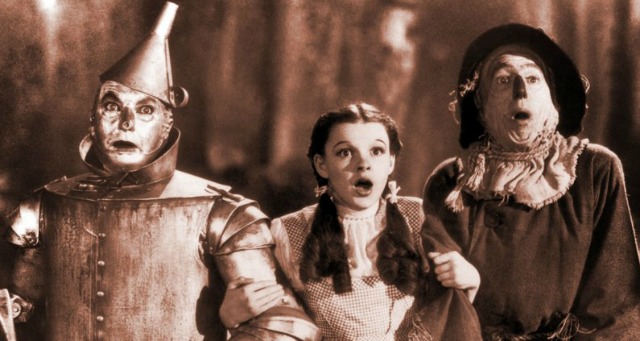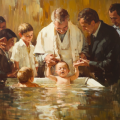Question
Gramps,
I’m sure Adam and Eve must have been baptized. Who might have performed these ordinances for them? If Peter, James, and John ordained Adam to the priesthood then he would have baptized Eve, but who might have baptized Adam? Did he have to wait until Cain or Abel was old enough and ordained to the priesthood?
Donna
Answer
Donna,
In Moses 6:64 Adam’s baptism was a unique event. The scripture states,
And it came to pass, when the Lord had spoken with Adam, our father, that Adam cried unto the Lord, and he was caught away by the Spirit of the Lord, and was carried down into the water, and was laid under the water, and was brought forth out of the water.
This passage suggests that Adam’s baptism was not performed by another mortal or even a resurrected being but rather through divine intervention.
This understanding aligns with the belief that God can perform ordinances through His power, even in the absence of a mortal priesthood holder. The act of being “caught away by the Spirit” indicates a profound spiritual experience, emphasizing the sacredness of the moment. This perspective is crucial for members of the Church, as it shows the belief that God is actively involved in the ordinances of His children.
In the Book of Mormon, we find another example of a baptism that raises similar questions. Alma, a prophet and priest, baptized himself and others without the formal authority of a priesthood holder at that time. In Mosiah 18:12-15, Alma states,
12 And now it came to pass that Alma took Helam, he being one of the first, and went and stood forth in the water, and cried, saying: O Lord, pour out thy Spirit upon thy servant, that he may do this work with holiness of heart.
13 And when he had said these words, the Spirit of the Lord was upon him, and he said: Helam, I baptize thee, having authority from the Almighty God, as a testimony that ye have entered into a covenant to serve him until you are dead as to the mortal body; and may the Spirit of the Lord be poured out upon you; and may he grant unto you eternal life, through the redemption of Christ, whom he has prepared from the foundation of the world.
14 And after Alma had said these words, both Alma and Helam were buried in the water; and they arose and came forth out of the water rejoicing, being filled with the Spirit.
15 And again, Alma took another, and went forth a second time into the water, and baptized him according to the first, only he did not bury himself again in the water.
This passage illustrates that Alma acted under divine inspiration, suggesting that the authority to perform baptisms can come directly from God, even in the absence of a formal priesthood structure.
The parallel between Adam’s baptism and Alma’s experience highlights a consistent theme in the scriptures: the importance of divine authority and inspiration in performing sacred ordinances. This understanding can help clarify the confusion surrounding who baptized Adam, reinforcing the idea that God can and does intervene in the lives of His children.
One of the central questions surrounding Adam’s baptism is the nature of authority in performing ordinances. In The Church of Jesus Christ of Latter-day Saints, it is taught that all saving ordinances must be performed by someone holding the proper priesthood authority. However, the unique circumstances of Adam’s baptism challenge this notion. If Adam was baptized by divine intervention, it raises questions about the necessity of mortal authority in the early dispensations of the gospel.
The teachings of the Church suggest that while priesthood authority is essential, God can bestow His power in extraordinary circumstances. This perspective is supported by the experiences of prophets like Alma, who acted under divine direction without formal authority. Thus, Adam’s baptism can be seen as a special case where God’s direct involvement superseded the need for mortal authority.
Another intriguing aspect of Adam’s baptism is the potential involvement of angels or divine messengers. In the writings of Hugh Nibley, it is suggested that Adam received teachings and ordinances from heavenly beings. These accounts indicate that Adam was not alone in his spiritual journey; he had divine assistance in understanding the ordinances of the gospel.
The idea that angels were sent to teach Adam and Eve the law of chastity and other ordinances reinforces the belief that God provides guidance and support to His children. This perspective can help members of the Church understand the significance of divine messengers in the context of baptism and other ordinances, emphasizing the collaborative nature of God’s plan for His children.
In contemporary practice, baptism remains a cornerstone of faith for members of The Church of Jesus Christ of Latter-day Saints. It is viewed as a necessary step in the journey of discipleship, symbolizing the commitment to follow Jesus Christ and live according to His teachings. The Church teaches that baptism is not only a personal covenant but also a communal one, connecting individuals to the larger body of believers.
The significance of baptism extends beyond the individual; it is a communal act that binds members of the Church together in their shared faith. This understanding can help members appreciate the importance of baptism in their spiritual lives and the lives of their families and communities.
The question of who baptized Adam also invites reflection on the continuity of ordinances throughout the history of the Church. The teachings of the Church emphasize that the same ordinances performed in Adam’s time are still relevant today. This continuity points to the belief that God’s plan for His children has remained consistent, providing a framework for understanding the importance of baptism and other ordinances.
Gramps






